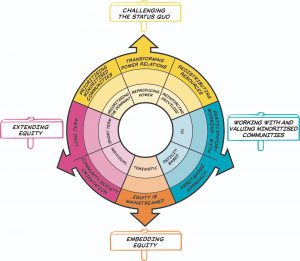An opinion piece on the ‘The Equity Compass: A tool for supporting socially just practice’
By s.godec, on 15 September 2021
Dr Uma Patel
In January 2021, a young black poet Amanda Gorman wowed people with her poem The Hill We Climb. Amanda recited “We will not march back to what was but move to what should be”. If you work with young people and their learning experience and want to move towards more socially just practice, in other words, “what it should be”, then read on.
What should be is not what it is now. Research shows that education and careers in science, technology, engineering and mathematics (STEM) are structured by privilege at the intersections of gender, ‘race’/ethnicity and class. Science learning experiences are not what they should be for many minoritised individuals and communities.
Equality means giving individuals and groups the same resources and opportunities. Equity and social justice go further and advocate differential treatment according to need while also recognising and valuing differences between people, and seeking to change the structures and practices that create and maintain inequalities.
The Equity Compass is a tool for framing action that arcs towards equity and social justice. The tool is underpinned by social science research and is designed to support practitioners and others to make decisions, plan, monitor and evaluate progress. The Equity Compass can be applied to events, programmes, spaces, policy and generally projects big and small.

The Equity Compass
The Equity Compass is a reflective tool for owning action that is transformative, in the interest of minoritised communities, determinedly asset-based, collectively oriented, and one where equity is mainstreamed and embedded (i.e. foundational, not tokenistic). It is the action that is ‘with’ participants (not ‘to’ or ‘for’ them). It is the action that involves a redistribution of resources.
The Equity Compass tool introduces concepts and vocabulary to anchor equity-focused conversations. As one informal science practitioner reflected: “intuitive understanding and ‘lovely’ doesn’t cut it ….the Equity Compass [Tool] helped us to articulate and find a voice to convince colleagues, funders and the public.”
For more details about the Equity Compass and further explanation of the terminology, see two YESTEM Insights. Working closely with practitioners, we produced the Equity Compass for informal STEM learning (see our resources on yestem.org) and later developed the Equity Compass insight for primary and secondary teachers.
With a will to change – “to move to what should be”, the Equity Compass has the potential to transform practice within the informal STEM learning sector and beyond. This task is not easy, but as Amanda Gorman said, a more just world is possible, but only “If we’re brave enough to see it, If only we’re brave enough to be it.”
 Close
Close

